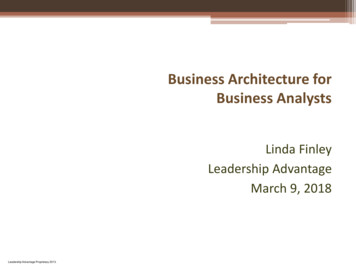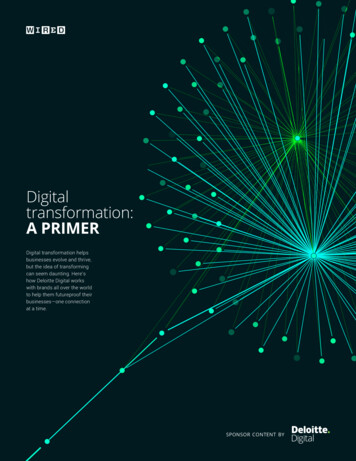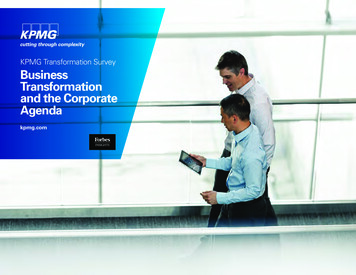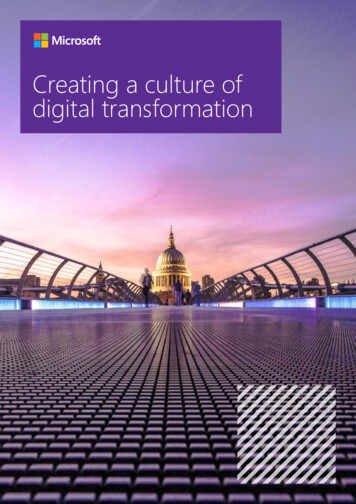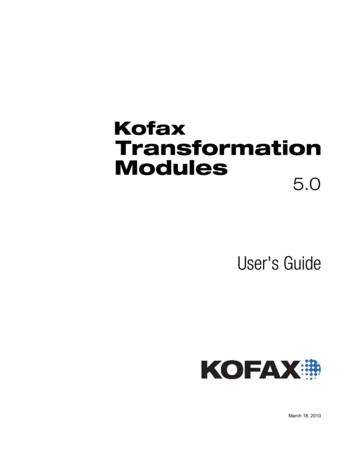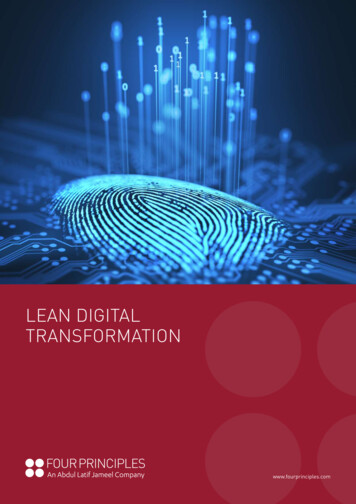
Transcription
Business-Driven, ITArchitecture TransformationWilliam Ulrich1President, TSG, Inc.Partner, Business Architecture AssociatesPresident, Business Architecture GuildFellow, Cutter ConsortiumCo-chair, OMG Architecture-Driven Modernization Task ForceCopyright TSG, Inc. 20183/19/2018
2Today’s topics Defining business vs. IT architecture, alignment and transformation Business risks, challenges and assessing technical debt Role of business architecture, from strategy definition through solutiondeployment Leveraging the business architecture / IT architecture transformationframework Framing IT architecture transformation through a business perspective Shifting to a business-driven, IT transformation approachCopyright TSG, Inc. 20183/19/2018
Terminology Level Setting: Business / IT ArchitectureAlignment & Transformation3 Business Architecture Definition Business architecture represents holistic, multidimensional business views of: capabilities, end-to-endvalue delivery, information, and organizational structure; and the relationships among these businessviews and strategies, products, policies, initiatives, and stakeholders.1 IT Architecture Definition Business / IT Architecture Alignment “Blueprints of the technologies, data structures and applications that collectively comprise the informationtechnology (IT) environment of an enterprise.”2State in which automated systems and data architectures fully enable business strategy, businesscapabilities and stakeholder valueBusiness / IT architecture transformation is the means of achieving “alignment”(1) Source: Federation of Enterprise Architecture Professional Organizations, adopted on January 14, 2017, after passing a vote by FEAPO Member Organizations.(2) Source: “Business Architecture: The Art & Practice of Business Transformation”, MK Press, 2010Copyright TSG, Inc. 20183/19/2018
4Business Architecture Domain Overview: Mappingthe Business EcosystemStakeholdersPolicies, Rules,RegulationsCapabilitiesOrganizationProducts &ServicesVision,Strategies &TacticsInformationValue StreamsInitiatives& ProjectsMetrics &MeasuresCopyright TSG, Inc. 2018Business ArchitectureSource: A Guide to the Business Architecture Body of Knowledge (BIZBOK Guide), v6.0, Part 1, Business Architecture Guild3/19/2018
5Business Architecture Differentiators Business architecture is foundational, transcending a given initiative or scenario Business architecture is reusable Business architecture scales horizontally and vertically Business architecture is not constrained to internal views Business architecture improves other disciplines Business architecture is politically agnostic*Source: Business Architecture Guild, BusinessArchitecture Quick Guide, 2017Consider one value stream example:“Take a Trip” value stream traces entirecustomer end-to-end journeyCopyright TSG, Inc. 20183/19/2018
6Breaking Down IT Architecture Blueprints of data structures, applications andtechnologies that represent current and / ortarget state of IT deployments Application architectureIT ArchitectureApplications,services &orchestrations Data architecturePhysical &logical datadeployments &representationsgsines ycleCocthlyPrnMo Technical architecture Shadow systems IT architecture should not be confused withthe IT organization The IT organization is just another business unitin a business ecosystemCopyright TSG, Inc. 2018Desktop &businesssystems out ofIT’s controlUnderlyingplatforms &technologies3/19/2018
TechnicalArchitectureData ViewData ArchitectureBusinessAutomation &Services ViewBusiness ArchitectureApplicationArchitectureBusiness ViewEnterpriseArchitecture7Quickly Sorting through the ArchitectureJargon: Why it MattersSolution ArchitectureSource: Business Architecture GuildBIZBOK Guide, v6.0, Part 1Platform & EnablingTechnology ViewInitiative or PortfolioArchitecture PerspectiveAbility to deliver real business value is realized and enhanced through formalintegration of business and IT at the architecture levelCopyright TSG, Inc. 2018*Source: “Business Architecture: Putting “Business” into EnterpriseArchitecture”, Ulrich, W. & Soley, R., May 2016, CIO Review3/19/2018
8How a Business Accrues Technical Debt Technical Debt Results from applying IT architecture changes that degrade data and application architectures over anincreasingly elongated timeframe Each set of changes increases time and cost of applying future changes, curtailing a business’s abilityto accommodate strategic objectives and business vision Technical debt is driven by: IT architectures that have grown increasingly misaligned to business model Continuous pressure to apply more changes to IT architectures never meant to support rapidly shiftingbusiness models Lack of executive understanding that technical debt is being incurred and that it presents a significantand growing risk to the businessCopyright TSG, Inc. 20183/19/2018
Technical Debt Results In:9 Inability to address customer discontinuity across business units and product lines Diminished capacity to manage risk, regulatory compliance, change management and crises* Business costs escalate as the business works around core IT systems IT solutions result in more business disruptions than they resolve Essential requirements are applied inconsistently or missed altogether Ongoing IT investments appear fully disconnected from priority business challenges and objectives,creating significant business risks*Business Architecture Now, Not Later? A Lesson from Crisis ManagementBrightTALK Recorded 13 April 5Copyright TSG, Inc. 20183/19/2018
Evaluating Technical Debt From a Business PerspectiveMatrix represents ITarchitectures as a wholeor portions thereofApplication systems areplotted on this matrixInitiatives may use thisplotting approach basedon the applicationsimpactedContinuous business / ITarchitecture alignment,with minimal disruptionand capital investmentLevel of IT & business architecture misalignment10Copyright TSG, Inc. 2018Complete IT architecturereplacement required, whichtriggers major, highlydisruptive capital investmentMajor IT portfolio investmentneeded to align business & ITarchitectures & address ITarchitecture degradationDegradation of data, application and technical architecturesSource: Business Architecture Associates, Inc.3/19/2018
IT Investments Must Look Beyond Technical Architecture toAddress Technical Debt, Business Challenges11 Business Architecture“Rainbow Model” represents transformationaljourney that concurrently transformsbusiness architecture and data, application,application and technical architecturesData ArchitectureApplication ArchitectureTechnical ArchitectureSOA, Cloud,VirtualizationSolution value grows when youmove up architectural stackCurrent State / Target State Transformation PathsWhen journey only travels acrosstechnical architecture, business valueis highly constrainedCurrent-to-target state transformation comprises many individual initiatives moving towards common business objectives,in cohesive fashion, over extended period of timeCopyright TSG, Inc. 2018Source: “Architecture-Driven Modernization: Transforming the Enterprise”, Dr. Vitaly Khusidman,William Ulrich, 2008, http://www.omgwiki.org/admtf/doku.php3/19/2018
Implications of Rainbow Model on IT BudgetAllocation & Business Funding12 At many organizations, IT will spend 10’s or 100’s of millions of dollars annually, whether thoseinvestments are business-driven or not It is incumbent upon the business to ensure that these investments are business-driven anddeliver business value by: Framing investments in business terms that clearly articulate and reconcile business objectives andinvestment focal points within the business, before the discussion shifts to IT Ensuring that all IT investments have traceability back to business objectives and impacted business focalpointsIT spending is a constant; but can the business directly trace dollars spent back to theimprovement in customer and related stakeholder value and overall improvement in businesscapabilities?Copyright TSG, Inc. 20183/19/2018
Business / IT ArchitectureAlignment Sample Metrics- Capability InstancesAcross IT Assets- Capability AutomationPercentages- Capability AutomationPercentages AcrossValue Stream StagesMetrics require businessto-IT architecture crossmappingsLevel of IT & business architecture misalignment13Transformation Planning Leverages BusinessArchitecture Based Technical Debt MetricsQuadrant IIQuadrant I416Application253Quadrant IIIQuadrant IV8IT Architecture Metrics- Reliability- Security- Maintainability- PerformanceEfficiencyMetrics supported by workfrom Consortium for ITSoftware Quality (CISQ)10911712Degradation data, application and technical architecturesCopyright TSG, Inc. 2018Source: Business Architecture Associates, Inc.3/19/2018
Decision matrix provides rapidanalysis for executives to:-Invest wisely in business-aligned ITsolutions (Q II / Q III)Determine when technical architectureupgrade satisfies business needs (Q IV)-Avoid reinvesting in fully bankrupt ITassets (Q I)-Evaluate among business/IT alignmentscenarios, such as cross-business unitsystem consolidation, transform in place,migrate to new IT architectureApplicationQuadrant IQuadrant IILevel of IT & business architecture misalignment14Using Technical Debt Matrix as input to BusinessDriven, IT Transformation & InvestmentsViability technology,misaligned to business modelrequires new functionality124Business/IT architecturemisalignment, IT foundationrequires major architecturalinvestment53Quadrant IVQuadrant III8IT architecture aligned tobusiness, viable foundationfor moving forward109Business/IT architecturealigned, requires investmentin IT architecture foundation712Degradation data, application and technical architecturesCopyright TSG, Inc. 20186Source: Business Architecture Associates, Inc.3/19/201811
15What Technical Debt Analysis from a Business andan IT Perspective Tells Us Capability mapping to IT architectures exposes major IT architecturechallenges by exposing: Massive capability-related redundancies, where what the business does isimplemented in hundreds or thousands of systems and technologies Fragmentation and inconsistencies in what the business does Redundancies, fragmentation and inconsistencies: Lead to poorly aligned and often conflicting information and related business challenges Destabilize IT architectures, making them particularly difficult to change in substantiveways Stymie investments to align IT architectures to business strategy and business architecture The good news: capabilities, and business architecture in general, provide insightsinto phased transformation options and related business-driven strategiesCopyright TSG, Inc. 20183/19/2018
Business Architecture: Framing Strategy Definitionthrough Solution Deployment16BusinessStrategyViewed ViaBusinessArchitectureStakeholdersPolicies, tionableResultsEstablish / RefineBusinessStrategyAssess nitiative PlansDeploySolutionStrategy DefinitionBusiness ScenarioDefinitionTarget StateArchitectureVIsualizationInitiative DefinitionDeployment s Objective /Value Stream ImpactAnalysisBusiness Arch. /Case ManagementDesignActionableObjectives / InitiativeMappingDeliverableDevelopmentObjective DefinitionBusiness Objective /Capability ImpactAnalysisBusinessArchitecture /Business ProcessDesignInitiativeMeasurementCriteria CreationCurrent State /Target StateTransformationManagementAction ItemDefinitionBusiness Objective /Information ImpactAnalysisBusiness-Driven ITArchitectureDefinitionInitiative Tradeoff /Decision DefinitionSuccess EvaluationObjective / ActionItem MatchingBusiness Objective /Business Unit ImpactAnalysisCurrent State /Target StateTransformationAnalysisInitiative MappingObjective TradeoffAnalysisBusiness Objective /Product ImpactAnalysisTarget State OptionAnalysis ecture / ITArchitecture ImpactAnalysisStrategyDisseminationAction Item DefinitonBusiness architecture:Vision,Strategies &Tactics- Informs strategy- Interprets strategy- Provides rapid business and ITarchitecture impacts prior to projectdefinitionInformation- Helps frame initiativesProducts &ServicesValue StreamsInitiatives& ProjectsMetrics &Measures- Used end-to-end to scoperequirements, frame IT deployments- Ensures link back to businessobjectivesCurrent StateArchitectureVisualizationBusiness ArchitectureCopyright TSG, Inc. 2018Source: Business Architecture Guild, BIZBOK Guide v6.03/19/2018
17Leveraging the Business Architecture / IT ArchitectureTransformation Framework ard tboOn plicanApCurrent BusinessArchitectureeidat nVal licatiopApStakeholdersqAck/Risess ilityAss ligibEucrodtvepro tAp uesReqePuirBusiness TransformationPolicies, Rules,RegulationsCapabilitiesBusiness ArchitecturePositioned Visioncess tPro menPayVision,Strategies &Tacticslish yab olicEst nt / PouAccOrganizationInformationtifyNo omerstCuCapability MapProducts &ServicesInformation MapBusiness / IT CurrentArchitecture MappingSynchronized Business / ITTransformationValue StreamsInitiatives& ProjectsMetrics &MeasuresBusiness ArchitectureSynchronization of TargetBusiness Perspective & TargetIT ArchitectureIT TransformationCurrent ITArchitectureCopyright TSG, Inc. 2018Target ITArchitectureSource: TSG, Inc.3/19/2018
To Maximize Value, IT Investments Must be ReadilyTraceable to Clearly Defined Business Objectives18 Steps to ensuring that IT investments are driven bybusiness objectives: Business Strategy / ObjectivesSet clear, measureable, attainable business objectivesValue Stream Frame objectives through capability, value stream,information and stakeholder perspectivesFrame IT architecture impacts through businessarchitecture lens Highlight current state IT architecture constraints to thedelivery of business objectives Align IT transformation plans with corresponding businesstransformation plansCopyright TSG, Inc. apabilityServiceAutomatedbyAligns objectterm & definitionInformationUses / modifiesDataProvidesbusiness viewBusiness ArchitectureIT Architecture View3/19/2018
19Leveraging Capabilities to Define SOA, Microservice& Cloud ArchitecturesTarget State Architecture Concepts:Microservices:-Organized around capabilities*-Capabilities and (micro) services share commonprinciples, both being object based-Capability decomposition enables microservicedefinition and refinementCurrent to Future State IT Architecture LeveragingCapabilities to Define Legacy Impacts, Future State ServicesCloud deployment-Capability usage across business unit and valuestreams provide key input to cloud strategy context-Generally, supporting and non-core capabilities aremore cloud suitable-In all cases, capability framed services providesgreater business agility and cloud options, now or laterCopyright TSG, Inc. 2018*Microservices, l3/19/2018
20Business-Driven, IT Architecture Alignment &Transformation Requires a Robust KnowledgebaseInitiativeBusiness / ITArchitectureKnowledgebaseInitiativeImpactsValue StreamValue Stream Stage Relieson ApplicationValueStreamApplicationValue StreamContains ValueStream StageInitiativeImpactsCapabilityBusiness UnitEngaged inInitiativeBusinessUnitCapabilityAutomatedBy ApplicationValue StreamStageCapability EnablesValue Stream StageBusiness Unit Hasa CapabilityInformationCapability Requires /Modifies pabilityCapability AutomatedBy ServiceApplication Accesses/ Modifies DataService Requires/ Modifies DataDataData is DerivedFrom InformationBusiness Unit Uses ApplicationClearly defined relationships among business and IT architecture domains within business architecture knowledgebase areessential to business-driven, IT architecture alignment and transformationCopyright TSG, Inc. 20183/19/2018
21Businesses Should Seek Continuous, Non-Disruptive,Business-Driven, Business / IT AlignmentBusiness / IT ArchitectureContinuous Alignment ModelBusinessArchitectureAlignment &Transformation Today, most businesses undergo disruptive, large-scale, veryexpensive IT transformations These transformations are characterized by many individualbusiness unit investments in siloed IT systems This pattern of disruption will continue until businesses shift to abusiness-driven IT transformation and investment approach Businesses should seek to achieve continuous, non-disruptivetransformative alignment, driven by business objectives from aholistic perspectiveIT ArchitectureCopyright TSG, Inc. 20183/19/2018
Shifting to a Business-Driven, IT TransformationPerspective22 Shift from a business unit-specific, application architecture-driven approach toframing IT investments from a capability and stakeholder value perspective Where IT programs and investments are not traceable to business objectives,reestablish the link to strategy as viewed through capability, value stream andstakeholder lens Frame initiatives from a business perspective and not simply based on theapplication systems involved in the effort Highlight overlap of initiatives based on capability and value related impacts Consider the direct business value of every IT dollar spentCopyright TSG, Inc. 20183/19/2018
Business-Driven, ITArchitecture TransformationThank You!William Ulrich23President, TSG, Inc.Partner, Business Architecture AssociatesPresident, Business Architecture GuildFellow, Cutter ConsortiumCo-chair, OMG Architecture-Driven Modernization Task ForceCopyright TSG, Inc. 20183/19/2018
Source: A Guide to the Business Architecture Body of Knowledge (BIZBOK Guide), v6.0, Part 1, Business Architecture Guild. Initiatives & Projects. Stakeholders. Products & Services. Vision, Strategies & . business architecture and data, application, application and

